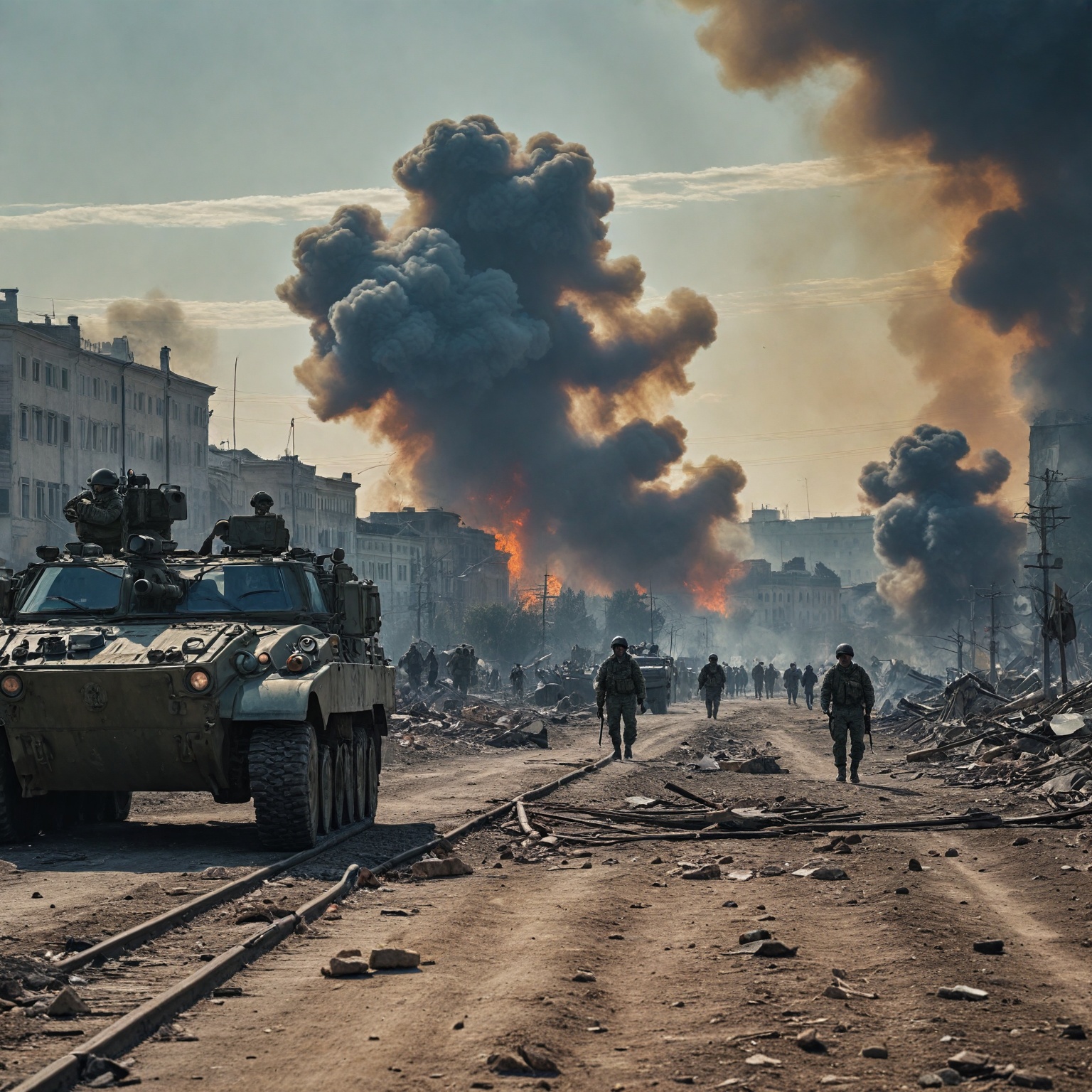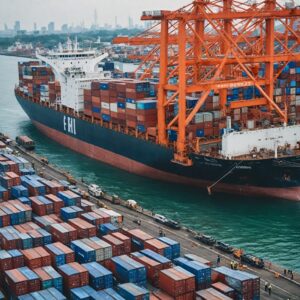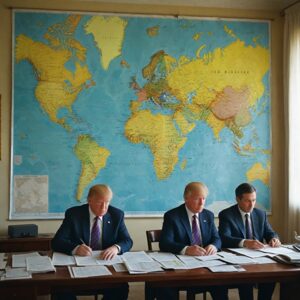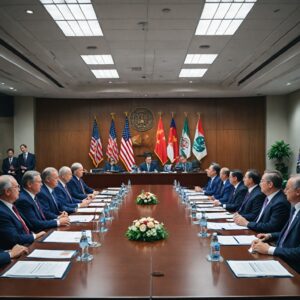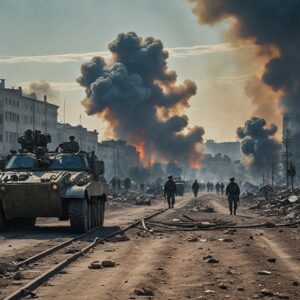Summary
Russia’s Provocation Trumps Race to Secure Ukraine Peace in His First 100 Days examines the complex interplay between Russia’s aggressive actions toward Ukraine and the diplomatic efforts, or lack thereof, undertaken during the initial period of Donald Trump’s presidency. Rooted in a conflict that escalated with Russia’s 2014 annexation of Crimea and support for separatists in eastern Ukraine, the situation remained volatile through continued military buildups, disinformation campaigns, and intermittent clashes. Russia’s maneuvers during this time—including troop deployments and political provocations—heightened tensions and complicated peace prospects.
Despite campaign promises from Trump to resolve the conflict swiftly, his administration’s approach involved appointing envoys and signaling intent to pursue peace within 100 days, but without concrete proposals or direct shuttle diplomacy between Kyiv and Moscow. Russian disinformation efforts intensified during this period, aiming to undermine Ukraine’s government legitimacy and fracture Western support, further impeding diplomatic progress. Meanwhile, Russia maintained military pressure and strategic ambiguity in its operations, signaling a persistent challenge to achieving a negotiated settlement.
The broader conflict has had significant regional and international implications, including disruptions to global energy markets, shifts in geopolitical alignments toward Western alliances by Ukraine, and ongoing legal actions against Russia in international courts. Efforts by Ukraine and its allies to hold Russia accountable for violations of international law underscore the war’s impact beyond the battlefield. The diplomatic isolation of Russia, including widespread expulsions of Russian diplomats, reflects the severity of the global response.
This article contextualizes Russia’s provocations within the early Trump administration’s limited peace initiatives, highlighting the persistent difficulties in resolving Europe’s most serious conflict since World War II. It also addresses the influence of information warfare, military strategy adaptations, and international legal proceedings that continue to shape the evolving crisis and the prospects for peace.
Background
The conflict between Russia and Ukraine has its roots in longstanding political, cultural, and territorial disputes, which escalated dramatically in 2014 when Russia annexed Crimea and supported separatist movements in the Donbas region of eastern Ukraine. This marked the first instance since World War II that a European state annexed the territory of another, triggering widespread international condemnation and the onset of a protracted conflict. The annexation followed months of unrest, including the Euromaidan protests in Ukraine and Russia-backed armed seizures of government buildings in the east, which culminated in an armed conflict between Ukrainian forces and Russian-supported separatists.
Since the illegal annexation, Ukraine has increasingly oriented itself towards Western alliances such as NATO and the European Union, reflecting a significant shift in popular sentiment away from Moscow’s influence. The conflict remained localized in the east until February 24, 2022, when Russian forces launched a large-scale invasion of Ukraine from multiple fronts, including Belarus, Russia, and the annexed Crimea. This invasion followed months of intelligence reports warning of a possible Russian offensive, which was widely anticipated by the international community.
Throughout the years of conflict, Russia has employed a multifaceted strategy involving political warfare, information operations, and military provocations aimed at destabilizing Ukraine both politically and militarily. Russian media narratives have painted the Ukrainian government as an illegitimate regime, fueling separatist sentiments in eastern Ukraine. Despite these efforts, Ukrainian forces have demonstrated resilience, combining tactical agility and international support to reclaim significant territories and resist Russian advances.
Diplomatic relations between Russia and Ukraine have effectively ceased, with no bilateral engagements taking place amid ongoing hostilities. The prolonged conflict has also prompted international legal actions, with cases brought against Russia alleging systematic human rights violations and breaches of international law. Meanwhile, global geopolitics, including energy markets and international diplomacy, have been significantly impacted by the war, underscoring the conflict’s broader strategic significance.
Russia’s Provocations in Context of Trump’s First 100 Days
In the lead-up to and during the first 100 days of Donald Trump’s presidency, tensions between Russia and Ukraine remained high, marked by significant military buildups and persistent disinformation campaigns. On November 13, 2021, Ukrainian President Volodymyr Zelenskyy reported that Russia had amassed approximately 100,000 troops near the Russo-Ukrainian border, a figure notably higher than U.S. intelligence estimates of around 70,000 troops. Despite these alarming developments, Russian President Vladimir Putin publicly denied any plans for invasion, dismissing the concerns as “alarmist” while simultaneously accusing NATO of unscheduled naval drills in the Black Sea region.
Throughout this period, Russia intensified its use of disinformation aimed at undermining Ukraine’s legitimacy and sowing discord between the United States and Ukraine. Following Trump’s electoral victory, Russian disinformation efforts sought to drive a wedge between Kyiv and Washington, as part of a broader campaign to weaken support for Ukraine within Western democracies. Russian propaganda portrayed Ukraine’s government as an illegitimate “fascist junta” and framed ethnic Russians in Ukraine as being under imminent threat, especially in the Donbas region where separatist sentiments were more prevalent. This narrative supported Russia’s broader strategic goal of destabilizing Ukraine and justifying its military interventions.
Despite Trump’s campaign promise to swiftly end the conflict—vowing to resolve it within “24 hours” or even before his inauguration—the reality was more complex. His administration’s chosen envoy, retired Lieutenant General Keith Kellogg, proposed a 100-day timeline to achieve a peace deal, emphasizing a sustainable and solid solution to halt the ongoing carnage. However, in practice, no concrete peace proposals were formally presented to Ukrainian leadership, and no shuttle diplomacy occurred between Kyiv, Moscow, and Trump’s team at Mar-a-Lago during this period.
Meanwhile, Russia continued military operations that deviated from its previous patterns of clear and articulated objectives, reflecting a strategic opacity that complicated diplomatic efforts. The Kremlin’s actions included the use of Ukrainian detainees as tools of political blackmail and disinformation, while electoral cycles in target countries appeared to influence the timing and intensity of interference activities. These provocations, coupled with Russia’s refusal to acknowledge the territorial integrity of Ukraine and ongoing efforts to consolidate control over annexed and occupied regions, underscored the challenge of achieving a negotiated settlement.
Timeline of Key Events During Trump’s First 100 Days Related to Ukraine
In the initial phase of Donald Trump’s presidency, significant attention was focused on the ongoing conflict in Ukraine following Russia’s full-scale invasion. Throughout Trump’s first 100 days in office, his administration made several public statements and diplomatic efforts aimed at addressing the war, although tangible progress toward peace remained elusive.
On January 31, 2017, shortly after taking office, Trump declared that his administration had engaged in “very serious” discussions with Russia and expressed optimism that he and Russian President Vladimir Putin could soon take “significant” action to end the conflict in Ukraine. This marked one of the earliest public indications that the new U.S. government intended to actively pursue diplomatic solutions in the region.
During this period, retired Lieutenant General Keith Kellogg was appointed as Trump’s special envoy to Ukraine and Russia. Kellogg publicly proposed a 100-day deadline to broker a peace agreement aimed at halting the war’s violence and preventing further casualties. Kellogg emphasized the importance of developing a “solid” and “sustainable” resolution, indicating the administration’s intent to work toward ending the conflict within this timeframe.
Despite these ambitions, Trump’s campaign promise to end the war in Ukraine “within 24 hours” of taking office remained unfulfilled by the end of his first 100 days. Sources close to Ukraine’s government and former U.S. diplomats noted that the Trump administration did not present a formal peace proposal to Kyiv, nor was there evidence of shuttle diplomacy involving Kyiv, Moscow, and Mar-a-Lago during this early period. Members of Trump’s national security team later acknowledged the complexities involved in negotiating a viable peace deal.
Meanwhile, the conflict itself continued unabated, with ongoing Russian military strikes causing casualties and damage in Ukrainian cities such as Kharkiv and Sumy. The Kremlin was also reported to be engaging in disinformation and political manipulation related to Ukrainian detainees, tactics that intensified around electoral cycles and added further complexity to the situation.
The administration’s initial engagement with Russia over Ukraine during the first 100 days thus reflected a mix of high-profile statements and appointed envoys advocating for a swift resolution, yet these efforts faced significant practical and diplomatic challenges. The hoped-for breakthrough to end Europe’s most severe conflict since World War II did not materialize within this early period of the Trump presidency.
Russia’s Military Actions and Strategies in the Early Invasion Phase
Russia’s military involvement in Ukraine escalated significantly starting in 2014, initially employing a “hybrid approach” that combined disinformation campaigns, irregular fighters, regular troops, and conventional military support. This strategy aimed to destabilize Ukraine and assert Russian influence without a full-scale overt invasion. The hybrid tactics culminated in direct military actions such as the occupation of Amvrosiivka by Russian paratroopers supported by armored vehicles and artillery in August 2014, followed by the crossing of Russian military columns into Ukrainian territory near Novoazovsk, signaling an intensification of the conflict in the Donbas region.
Throughout this period, Russia’s military operations abroad were often characterized by deniability or semi-covert engagements, as seen in Crimea and Donbas, or overt operations with clear objectives, such as in Syria. However, during the first year of the full-scale invasion of Ukraine that began in 2022, Moscow deviated from its prior military doctrine by failing to consistently articulate a coherent strategic objective. This ambiguity contrasted with Russia’s usual practice of clear operational goals in its foreign military engagements since 2014.
The Russian military strategy has traditionally relied on concepts like deep battle and deep operation, which involve simultaneous attacks across the entire tactical and operational depth of the enemy’s formation using long-range artillery, air strikes, and mechanized forces to exploit breakthroughs. This doctrine requires dense troop concentrations along extended front lines and multiple echelons. However, advancements in precision targeting, long-range strikes, and reconnaissance-strike complexes have increased the vulnerability of such massed formations, forcing a shift towards dispersed and fragmented battlefield deployments to enhance survivability.
The evolving battlefield conditions in Ukraine have compelled Russian forces to adapt by employing smaller, more autonomous formations that can operate independently over a broader front. Remote and non-contact strikes using cruise missiles, ballistic missiles, UAVs, and precision munitions have become integral to Russia’s operational approach, targeting not only military forces but also economic and infrastructure assets deep behind enemy lines.
Despite these adaptations, Russian forces continued to make territorial gains in eastern Ukraine during 2024. Notably, they captured key locations such as Kurakhove in late 2024 and several towns near Pokrovsk, including Novohrodivka, Krasnohorivka, and Ukrainsk, further consolidating their presence in the Donbas region. These advances occurred amid internal Ukrainian military leadership changes and strategic withdrawals, such as the February 2024 replacement of General Zaluzhnyi by General Oleksandr Syrsky and the subsequent tactical retreat from Avdiivka to avoid encirclement, which nonetheless resulted in significant battlefield losses for Ukraine.
Prior to the 2022 invasion, Russia had amassed substantial military forces near Ukraine’s borders, including in Belarus, under the guise of military exercises. These buildups were met with denials from Russian leadership about any invasion plans, even up to the day before the full-scale attack commenced. Additionally, financial activities linked to Russian elites, including generals, involved investments and property in Ukraine for money laundering, highlighting the complex interplay between military aggression and economic interests.
Impact on Peace Efforts and Regional Stability
Since Donald Trump’s election victory, his administration has not presented a concrete peace proposal to Ukraine’s leadership, nor has there been any shuttle diplomacy involving Kyiv, Moscow, and Mar-a-Lago, according to sources close to Ukraine’s government and a former U.S. diplomat. Members of Trump’s national security team have acknowledged the complexities involved in brokering a durable peace agreement, with discussions suggesting a timeline of up to 100 days to develop a sustainable solution that could effectively end the conflict and halt ongoing casualties.
The ongoing conflict in Ukraine remains deeply intertwined with regional stability and international legal questions. Key issues include establishing responsibility for damages, setting up tribunals to punish perpetrators, and determining Russia’s future role in the international legal order, particularly its position in the United Nations Security Council. These legal and diplomatic considerations have been explored through policy proposals such as the ‘Options for a Peace Settlement for Ukraine’ published on the OpinioJuris blog.
The conflict has been marked by periods of heightened military escalation, as exemplified by January 2022 when Ukraine’s then-president Poroshenko reported a significant Russian troop buildup across the border. Despite agreements like Minsk II in 2015 aiming to cease hostilities, Russian-backed forces have repeatedly launched offensives, notably in strategic areas such as Debaltseve, undermining ceasefire efforts and regional peace. This persistent instability has complicated efforts to reach a lasting political resolution.
Advancements in military technology have further transformed the battlefield, complicating traditional troop deployments and altering combat dynamics. The increasing capability to detect and strike targets at extended ranges and with high precision—using tools such as cruise and ballistic missiles, weaponized unmanned aerial vehicles (UAVs), and precision airpower—has made concentrated troop formations highly vulnerable. Consequently, forces have been forced to disperse and adapt tactics, which fragments the battlefield and expands the operational depth, thereby challenging conventional peacekeeping and conflict resolution strategies.
On the international front, coalition-building efforts to support Ukraine militarily and economically have been initiated, such as the April 2022 meeting at Ramstein Air Base involving the U.S. and 40 allied nations. Nonetheless, U.S. intelligence officials have cautioned that no short-term resolution to the invasion should be expected, highlighting Ukraine’s dependence on Western-supplied equipment that is constrained by concerns over escalation if used to strike targets within Russia.
Ukraine’s experience with Russian hybrid warfare tactics and external interference over the past five years has underscored the broader threat to democratic states worldwide. Western democracies’ slow recognition of these threats contrasts with Ukraine’s front-line position as both a target and testing ground for such tactics. Failure by allies to analyze and document these attacks risks enabling Russia or other actors to replicate them elsewhere, thereby exacerbating global security challenges.
Diplomatic tensions remain high, with Russia accusing Ukraine of violating the Minsk Protocols and criticizing Western nations for arming Kyiv contrary to these agreements. Russia’s military deployments near Ukraine’s borders and Crimea have been characterized as threats to regional security by both Ukrainian officials and the Russian Defence Ministry, which has also condemned U.S. naval presence in the Black Sea as destabilizing. Ukraine’s National Security and Defence Council has responded by enacting strategies aimed at deterring external aggression, maintaining internal stability, and fostering cooperation with the European Union and NATO, explicitly identifying Russia as a military adversary conducting armed aggression.
Legal implications of the conflict extend to extraterritorial jurisdiction concerns, with the European Court of Human Rights (ECtHR) potentially holding Russia accountable for violations occurring beyond its recognized borders. This development may influence investors and international actors seeking recourse against Russia in relation to its invasion of Ukraine, reinforcing the notion that Russia’s territorial reach is contested and complex.
International Legal and Diplomatic Responses
The international community’s response to Russia’s invasion of Ukraine has been multifaceted, encompassing legal actions, diplomatic measures, and broader efforts to hold Russia accountable under international law. The International Court of Justice (ICJ), empowered by its Statute to admit States as interveners in cases concerning treaties to which they are parties, has seen significant engagement. In 2022, 33 States filed statements of intervention related to Ukraine, primarily drawn from European Union Member States and allied countries such as Liechtenstein, Norway, Canada, the United Kingdom, New Zealand, and Australia. These
Media Coverage and Public Perception
Since the onset of the conflict in Ukraine, media coverage and public perception have been profoundly influenced by competing narratives, particularly those stemming from Russian disinformation campaigns. Following Russia’s annexation of Crimea in 2014 and its incursions into the Donbas region, Russian propaganda has sought to delegitimize the Ukrainian state by portraying it as a failed entity governed by fascists and neo-Nazi sympathizers. This narrative has been a persistent element of Russian media efforts to shape both domestic and international opinion about the conflict.
One prominent example of Russian disinformation involved allegations during 2015–2016 that U.S. political figures, notably Hillary Clinton, were manipulated by Ukrainian oligarchs. Russian narratives claimed Clinton’s campaign was influenced by such interests, basing their assertions on the kernel of truth that her charitable foundation had received donations from Ukrainian oligarch Viktor Pinchuk. These claims were widely circulated in Russian media as part of broader efforts to undermine Western support for Ukraine and to sow distrust in Western democratic processes.
The international media have also closely tracked Ukraine’s military successes, especially notable during offensives in late 2022 when Ukrainian forces reclaimed significant territory from Russian control. Such developments have contributed to a prevailing narrative in global media portraying Ukraine’s defense as spirited and strategically effective, bolstered by international support. This portrayal has reinforced a public perception of Ukraine as a resilient actor capable of inflicting substantial setbacks on Russian forces.
Meanwhile, international legal and human rights organizations have contributed to shaping public understanding through their scrutiny of alleged violations of international law by Russia. Cases brought before bodies like the European Court of Human Rights and the International Court of Justice, including those concerning the annexation of Crimea and the downing of Malaysia Airlines Flight MH17, have kept legal and ethical dimensions of the conflict in the media spotlight. These proceedings have amplified global awareness of Russia’s actions and underscored the complex legal challenges arising from the war.
Analysis and Commentary
Since the onset of Russia’s full-scale invasion of Ukraine, international legal scholars and political analysts have extensively examined the conflict’s implications, strategies, and legal consequences. A significant focus has been placed on Russia’s war aims and its deviations from established military doctrine. Historically, since 2014, Russia’s military operations abroad tended to be either deniable and semi-covert, as seen in Crimea and the Donbas, or overt with clearly stated objectives, such as in Syria. However, during the first year of the full-scale invasion of Ukraine, Moscow notably failed to articulate a coherent and consistent strategic objective, diverging from its previous practices and established Russian military science postulates.
This inconsistency in Russia’s official narrative has led to widespread debate about its true intentions and the impact on the broader international legal order. Issues of international legal responsibility, the assessment of damages, and calls for the establishment of tribunals to hold perpetrators accountable have been central to discussions within the legal community. These discussions also extend to Russia’s future role in international institutions, including the United Nations Security Council, reflecting the broader geopolitical ramifications of the conflict.
Moreover, the invasion has galvanized a surge of scholarly activity and public discourse. Since 2022, numerous conferences, workshops, articles, and even books have been published to analyze and respond to the conflict. This body of work not only contributes to understanding the immediate crisis but also reshapes how legal research is conducted during times of active conflict.
Politically, Russia’s actions have also been interpreted as an attempt to destabilize Ukraine and undermine its political and military resilience. Analysts suggest that Russia’s probable calculation includes weakening Ukraine internally and externally, potentially using periods of relative calm to regroup and continue its destabilization efforts at a later stage. In response, Ukraine has adapted its diplomatic strategies, moving away from hopes of bilateral ceasefire talks after mid-2022 and instead seeking broader international support.
On the international stage, the conflict has intensified the divide between Western allies and Russia. Ukraine’s increasing orientation toward Western alliances, particularly NATO and the European Union, has been reinforced since Russia’s annexation of Crimea in 2014. This geopolitical realignment underscores the high stakes involved for Kyiv, which faces threats to its sovereignty and democratic development. In parallel, Western nations have actively coordinated military and economic support for Ukraine, exemplified by the April 2023 meeting of the US and 40 allied nations at Ramstein Air Base to form a coalition aimed at sustaining Ukraine’s defense capabilities.
Finally, the role of disinformation, particularly by Russia, has been recognized as a critical element in the conflict’s dynamics. Efforts to erode international support for Ukraine, especially within the United States, have been part of Russia’s broader strategic toolkit to influence perceptions and weaken alliances backing Kyiv. This multifaceted conflict, therefore, is not only a military confrontation but also a contest over information, legal norms, and international order.
Related Topics
The ongoing conflict in Ukraine, which escalated significantly following Russia’s full-scale invasion on 24 February 2022, has deep roots tracing back to the 2014 annexation of Crimea and the subsequent clashes between Ukrainian forces and Russia-backed separatists in eastern Ukraine. This prolonged conflict has influenced numerous international responses, including legal, diplomatic, and political efforts aimed at resolving the crisis and addressing human rights violations.
One notable dimension of the international response has been the active engagement of legal academia and human rights organizations, which have published extensive analyses and statements. For instance, Ukraine submitted formal observations on Russia’s preliminary objections at the International Court of Justice, reflecting ongoing efforts to pursue legal accountability. Despite mixed decisions by the Court, human rights advocates like Oleksandra Matviichuk emphasize the importance of continued legal action and improved evidence collection regarding abuses committed during the conflict.
Diplomatic relations have also been significantly affected. The Russian invasion prompted an unprecedented expulsion of over 200 Russian diplomats from numerous countries by early April 2022, signaling a broad international repudiation of Russia’s actions. This diplomatic isolation contrasts with Russia’s earlier global presence, when it maintained extensive diplomatic posts in 145 countries.
The conflict has further underscored the challenges posed by Russian “hybrid” warfare tactics, including disinformation campaigns and external meddling. Ukraine has served as a testing ground for these tactics over several years, highlighting the need for Western democracies to better recognize and counter such threats to prevent their replication elsewhere.
In the context of U.S. politics, former President Donald Trump and his associates have articulated plans and timelines for resolving the conflict should he return to office. Trump’s campaign spokesperson indicated that a top priority in a second term would be to quickly negotiate an end to the war, while his special envoy to Ukraine and Russia proposed a 100-day deadline to achieve peace. These statements reflect ongoing international interest and political maneuvers related to the conflict’s resolution and underscore the intersection between global diplomacy and domestic political agendas.

